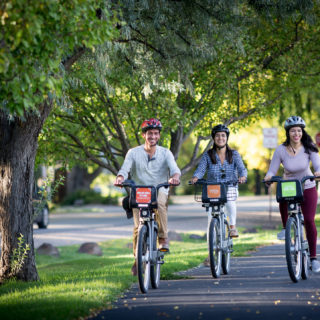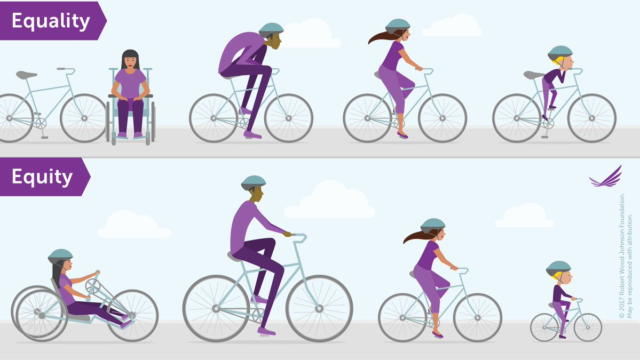Equity vs. Equality
by Farrah Daniel, Better Bike Share Partnership Writer
October 24, 2019
What is the significance of equity? Today, we’re talking about who needs it, what it looks like, and why it’s important.
Equality is about ensuring everyone the exact same resources, while equity requires distributing resources based on the different needs of the recipients.
Initially, I didn’t understand how equality wasn’t as important as equity in bike share. I thought to myself, don’t we all want to be equal and viewed the same way? It turns out we don’t. Being viewed through one lens means people and communities outside the cone of visibility get overlooked. Without making bike share accessible to everyone, a large population of potential riders doesn’t get to experience the benefits of micromobility.
This graphic created by the Robert Wood Johnson Foundation (@RWJF) does a great job of illustrating what it looks like when equality is deemed the solution. See how one size doesn’t fit all?
Equity and equality, or just equity?
This quote by Ayesha McGowan summarizes the difference; it also spurred the idea for this article:
“Recognize it’s about equity, not equality — equity is the solution, equality is not realistic at this time. Equity is defined as the quality of being fair and impartial despite preconceived notions and traditions. Equality is defined as the state of being equal, especially in status, rights, and opportunities. Equality is not possible right now because not everyone is starting from the same place. The industry has represented one type of cyclist for so long, that it’s got some catching up to do.”
Equity is vital because it means the individual needs of marginalized groups are being attended to rather than ignored. To dig deeper into the topic, I briefly spoke with Waffiyyah Murray, Program Manager of the Better Bike Share Partnership. She expanded on what’s needed to achieve equity: support, information, resources. Because we’re not all the same and have differing needs, “giving the same [bike share] resources with the assumption it’ll be successful leads to an unequal playing field.”
What/who is considered in equity?
- Available resources and information
- Gender
- Inclusivity—rather than tokenism—in marketing
- Low-income areas and communities of color
- People with disabilities
- Physical barriers
- Structural racism
And the list will continue to evolve as needs arise. The good news, however, is that more and more programs across the country are seeking ways to reach people in neglected communities — you can always find those stories on our site.
How are equity goals met in bike share?
We at the Better Bike Share Partnership are working towards equity by reducing the barriers for marginalized groups and people in low income and communities of color to access bike share. One barrier to gaining equity is the lack of understanding of it as well as assumptions about the needs of people in underserved communities. A crucial aspect of this is outreach.
The solution? Direct communication paired with listening and implementing. Having outreach teams and community ambassadors who go into communities to talk to participants, find out what people need and how to provide those resources are just some tactics used to bridge the gap in bike share accessibility.
Philadelphia, for example, was the first city to prioritize equity in its bike share program, Indego, from its conception. Among other things, the program incorporates a feasible payment structure that has given access to bike share for people in low income and communities of color. On top of that, the city’s Digital Skills, Bicycle Thrills program is available for community members to gain computer literacy, learn bike safety, understand how to operate the Indego system and more.
Detroit’s MoGo and Portland’s BIKETOWN have made strides in offering access to adaptive bikes and bike share programs that reach people with varying abilities.
Plus, the conversation is brewing about how to make bike share more accessible for women, girls, trans and nonbinary people. Nice Ride in Minnesota and CoGo Bike Share in Columbus are spreading the message with their hashtag #ClosetheFenderGap and participating in events that boost women’s empowerment and an increased presence in biking.
Of course, the work isn’t done, but it forges ahead as the trend of prioritizing equity takes off.
The Better Bike Share Partnership is funded by The JPB Foundation as a collaborative between the City of Philadelphia, the Bicycle Coalition of Greater Philadelphia, the National Association of City Transportation Officials (NACTO) and the PeopleForBikes Foundation to build equitable and replicable bike share systems. Follow us on Facebook, Twitter and Instagram or sign up for our weekly newsletter. Story tip? Email farrah [at] betterbikeshare.org.


